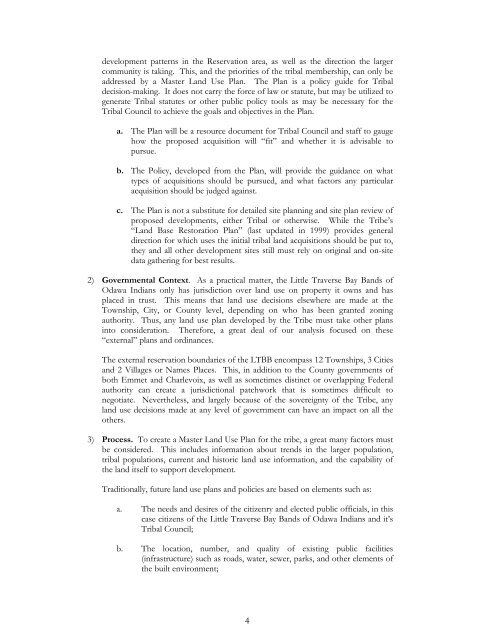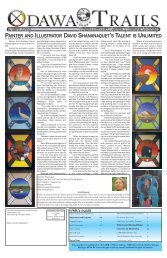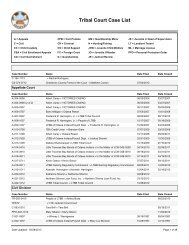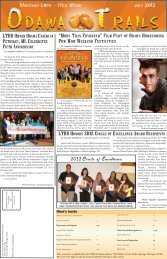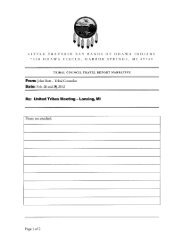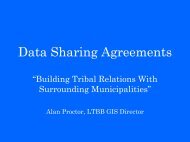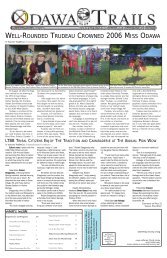LTBB Master Land Use Plan - Little Traverse Bay Bands of Odawa ...
LTBB Master Land Use Plan - Little Traverse Bay Bands of Odawa ...
LTBB Master Land Use Plan - Little Traverse Bay Bands of Odawa ...
Create successful ePaper yourself
Turn your PDF publications into a flip-book with our unique Google optimized e-Paper software.
development patterns in the Reservation area, as well as the direction the larger<br />
community is taking. This, and the priorities <strong>of</strong> the tribal membership, can only be<br />
addressed by a <strong>Master</strong> <strong>Land</strong> <strong>Use</strong> <strong>Plan</strong>. The <strong>Plan</strong> is a policy guide for Tribal<br />
decision-making. It does not carry the force <strong>of</strong> law or statute, but may be utilized to<br />
generate Tribal statutes or other public policy tools as may be necessary for the<br />
Tribal Council to achieve the goals and objectives in the <strong>Plan</strong>.<br />
a. The <strong>Plan</strong> will be a resource document for Tribal Council and staff to gauge<br />
how the proposed acquisition will “fit” and whether it is advisable to<br />
pursue.<br />
b. The Policy, developed from the <strong>Plan</strong>, will provide the guidance on what<br />
types <strong>of</strong> acquisitions should be pursued, and what factors any particular<br />
acquisition should be judged against.<br />
c. The <strong>Plan</strong> is not a substitute for detailed site planning and site plan review <strong>of</strong><br />
proposed developments, either Tribal or otherwise. While the Tribe’s<br />
“<strong>Land</strong> Base Restoration <strong>Plan</strong>” (last updated in 1999) provides general<br />
direction for which uses the initial tribal land acquisitions should be put to,<br />
they and all other development sites still must rely on original and on-site<br />
data gathering for best results.<br />
2) Governmental Context. As a practical matter, the <strong>Little</strong> <strong>Traverse</strong> <strong>Bay</strong> <strong>Bands</strong> <strong>of</strong><br />
<strong>Odawa</strong> Indians only has jurisdiction over land use on property it owns and has<br />
placed in trust. This means that land use decisions elsewhere are made at the<br />
Township, City, or County level, depending on who has been granted zoning<br />
authority. Thus, any land use plan developed by the Tribe must take other plans<br />
into consideration. Therefore, a great deal <strong>of</strong> our analysis focused on these<br />
“external” plans and ordinances.<br />
The external reservation boundaries <strong>of</strong> the <strong>LTBB</strong> encompass 12 Townships, 3 Cities<br />
and 2 Villages or Names Places. This, in addition to the County governments <strong>of</strong><br />
both Emmet and Charlevoix, as well as sometimes distinct or overlapping Federal<br />
authority can create a jurisdictional patchwork that is sometimes difficult to<br />
negotiate. Nevertheless, and largely because <strong>of</strong> the sovereignty <strong>of</strong> the Tribe, any<br />
land use decisions made at any level <strong>of</strong> government can have an impact on all the<br />
others.<br />
3) Process. To create a <strong>Master</strong> <strong>Land</strong> <strong>Use</strong> <strong>Plan</strong> for the tribe, a great many factors must<br />
be considered. This includes information about trends in the larger population,<br />
tribal populations, current and historic land use information, and the capability <strong>of</strong><br />
the land itself to support development.<br />
Traditionally, future land use plans and policies are based on elements such as:<br />
a. The needs and desires <strong>of</strong> the citizenry and elected public <strong>of</strong>ficials, in this<br />
case citizens <strong>of</strong> the <strong>Little</strong> <strong>Traverse</strong> <strong>Bay</strong> <strong>Bands</strong> <strong>of</strong> <strong>Odawa</strong> Indians and it’s<br />
Tribal Council;<br />
b. The location, number, and quality <strong>of</strong> existing public facilities<br />
(infrastructure) such as roads, water, sewer, parks, and other elements <strong>of</strong><br />
the built environment;<br />
4


